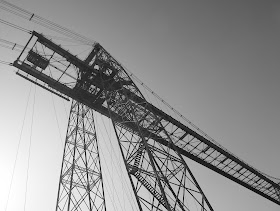Frenchman Ferdinand Arnodin, with Spaniard Alberto de Palacio, was the patentee holder for the first transporter bridge design brought to realisation, just outside of Bilbao, Spain. Five transporter bridges were built in France, more than in any other country: at Brest (relocated from Bizerta, Tunisia), Marseille, Nantes, Rochefort, and Rouen; with a sixth commenced at Bordeaux but never completed. All were designed by Arnodin. Only the Rochefort bridge remains to France.
Crossing the Charente River, construction of the 700 ton iron and steel Rochefort Transporter Bridge commenced in March 1898 and was completed in July 1900. The towers, marked with Arnodin's name on each of the 16 shoes, stand 217 feet high, and the bridge has an overall length of 575 feet, with a main span of 459 feet at beam level. The beam is 26 feet wide and 154 feet above high water level. The suspension cables terminate in massive anchorages (below). The uppermost cables run back to additional anchorages built in 1933 when the bridge was converted from being predominantly cable-stayed to being entirely of the suspension form.
The bridge was abandoned in February 1967 upon opening of a nearby vertical lift bridge, itself demolished in 1991 after opening of the Martrou viaduct road bridge (in background of first photo). Funds were put aside in 1975 for the bridge's demolition, but it was declared an historic monument in April 1976, and refurbished between 1990 and 1994.
The bridge is normally open in the summer months for use by pedestrians and cyclists. At the time of writing it has been closed for a predicted three year period, to replace the boom with one constructed much more closely in accord with Arnodin's original design, and to revert to the original largely cable-stayed format, at an estimated cost of £27 million. There is a good museum on the Échillais (Martrou) side of the river.






No comments:
Post a Comment